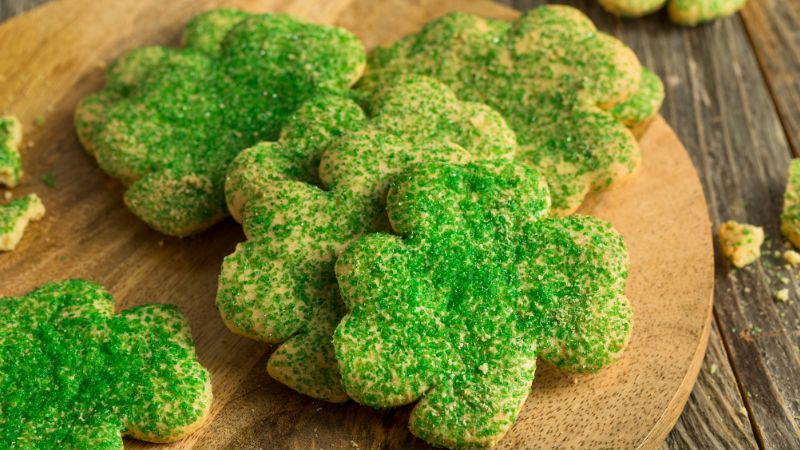Sugar cookies might seem like a simple treat, but they have a long and fascinating history. The earliest versions of sugar cookies date back to the 7th century, when Middle Eastern bakers began incorporating sugar in their pastries. As sugar made its way into Europe, butter-based cookies became more common, particuarly in Germany and England. By the 1700s, Pennsylvania Dutch settlers in the United States had developed their own version, often called Nazareth Sugar Cookies. These cookies laid the foundation for the classic sugar cookie we know and love today.
Sugar cookies fall into the rolled cookie category, meaning the dough is rolled out and cut into shapes before baking. This sets them apart from drop cookies (like chocolate chip) and slice-and-bake cookies (like shortbread). What makes sugar cookies unique is their ability to hold their shape while remaining tender, making them perfect for decorating and customization. With the right balance of ingredients, they offer a crisp edge with a soft center—ideal for both casual snacking and elaborate holiday designs.
Although the classic sugar cookie is a staple in many households, variations of this beloved treat can be found in cultures across the globe. Here are just a few international takes on sugar cookies.
- germany: spritzgebäck. A buttery, piped cookie with a delicate texture and rich flavor, similar to sugar cookies but often made with almond flour.
- sweden: pepparkakor. A spiced version of sugar cookies, traditionally cut into festive shapes and enjoyed during the holiday season.
- mexico: polvorones. Also known as “Mexican wedding cookies,” these crumbly, sugar-dusted delights are sometimes flavored with cinnamon or citrus.
- france: sablés. A crisp, buttery version of sugar cookies, often shaped into rounds and known for their delicate, melt-in-your-mouth texture.
Today, sugar cookies continue to evolve with endless flavor variations. From matcha and peanut butter to bourbon, bacon, and even black pepper, there’s no limit to the creative spins you can put on this classic dough. Marbled cookies, breakfast-friendly adaptations, and seasonal twists keep sugar cookies fresh and exciting year-round.
This recipe is a go-to for perfectly shaped, soft-but-sturdy sugar cookies. Here’s why.
- soft… but holds its shape. Perfect for decorating, without spreading too much.
- greek yogurt keeps them tender. Adds a subtle tang that balances the sweetness.
- easy to roll and cut. No sticky mess, just smooth, workable dough.
- customizable. Add your own favorite flavors, colors, and decorations for a unique touch.
final thoughts
Whether you’re making shamrock cookies for St. Patrick’s Day, festive Christmas shapes, or simple sprinkle-topped treats for an everyday indulgence, this sugar cookie recipe is a reliable favorite. The secret ingredient—Greek yogurt—not only keeps the cookies soft and tender but also enhances their flavor and structure.
So, grab your rolling pin and unleash your creativity! What’s your favorite way to decorate sugar cookies? Let us know in the comments! 🎉🍪
Equipment
- Rolling Pin
- cookie cutters optional
- piping bags for icing, if using
- mixing bowls
- measuring cups and spoons
- electric mixer or hand whisk
- baking sheet
- parchment paper
- cooling rack
Ingredients
- 1/2 cup butter 1 stick
- 1 cup granulated sugar
- 1 egg
- 1 tsp. vanilla extract (or any other extract/flavoring desired)
- 1/2 cup plain Greek yogurt
- 3 1/2 cups all-purpose flour
- 1 tsp. baking soda
- 1/2 tsp. fine salt
for decoration (optional)
- green sparkling sugar
- 2 cups powdered sugar
- 3-4 tbsp. milk
- 1/2 tsp. vanilla extract
- food coloring
Instructions
make the dough
- In a large bowl, beat butter and sugar together until light and fluffy.
- Mix in the egg and vanilla extract.
- Stir in the Greek yogurt until smooth.
- In a separate bowl, whisk together flour, baking soda, and salt.
- Gradually mix dry ingredients into the wet mixture until combined.
- Roll dough into a ball, wrap tightly in plastic, and chill for at least 1 hour.
roll and cut
- Preheat oven to 425°F (218°C).
- Roll out dough on a floured surface to about 1/4-inch thickness.
- Cut into desired shapes using cookie cutters.
bake
- Place cookies on a parchment lined baking sheet.
- Bake for 8 minutes exactly, or until edges are just set.
- Let cookies cool on the baking sheet for 5 minutes, then transfer to cooling rack.
decorate (optional)
- for sugar coated cookies: sprinkle with colored sugar before baking.
- for iced cookies: mix powdered sugar, milk, vanilla, and food coloring to create an icing. Pipe or spread onto cooled cookies.
storage + make-ahead tips
- Store in an airtight container at room temperature for up to 1 week.
- Dough can be chilled for up to 2 days before rolling.
- Baked cookies (undecorated) can be frozen for up to 3 months.
variations for various occasions
- shamrock cookies: cut into shamrock shapes and decorate with green sugar or icing.
- christmas cookies: use festive shapes like trees or stars and decorate with royal icing.
- lemon sugar cookies: add the zest of 1 lemon for a bright, citrusy flavor.
- cinnamon spice cookies: add 1/2 tsp. cinnamon for warm twist.
Notes
Protein: 2g
Total Fat: 5g
Saturated Fat: 3g
Trans Fat: 0.1g
Cholesterol: 15mg
Sodium: 70mg
Total Carbohydrates: 16g
Sugars: 8g
Dietary Fiber: 0.5g ** The information provided on this blog is intended for general knowledge and informational purposes only, and does not constitute medical advice. It is essential to consult with a qualified healthcare professional or registered dietitian for any health concerns or before making any decisions related to your health or treatment. This blog does not provide any guarantees or warranties regarding the accuracy, completeness, or suitability of the information provided.



Leave a Reply